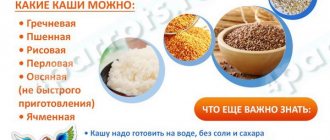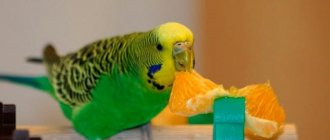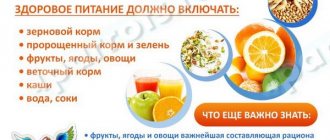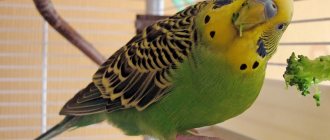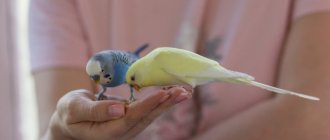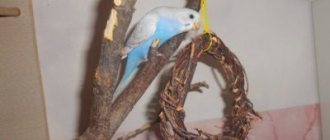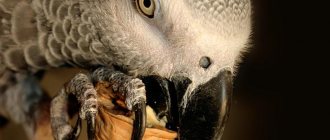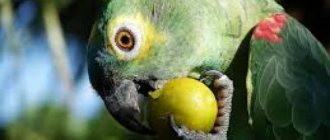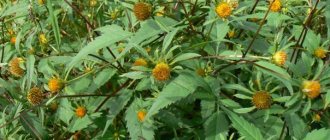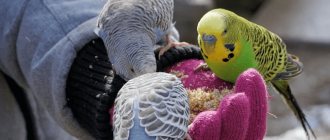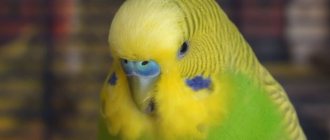Succulent herbs, seeds and fruits are what parrots eat in their natural environment. In warm Australia, there is food for birds at any time of the year. Exotic fruits and berries grow there, but the main food is seeds, cereals, and nuts. The diet of a parrot kept in captivity should be equally varied. With proper feeding, the pet will be healthy, active, and sociable. A poor diet can lead to disease and shorten the bird's lifespan.
When and how much to feed your parrot
One bird needs to be given two teaspoons of dry food daily. Some individuals are voracious and require much more. You need to monitor how much your pets eat, because budgies are prone to obesity. It is recommended to divide the daily dose and then offer it to the bird in parts. The patient should not be allowed to eat more than three spoons of the grain mixture.
Attention! Small birds have an accelerated metabolism. Lack of food can lead to negative consequences, even death. You can purchase an automatic feeder that will provide food in portions.
Additional food
The diet of budgerigars should also include additional food, in addition to those mentioned in our article above.
Porridge
Suitable for daily feeding. They should be cooked in water without salt, sugar, oil or seasonings. To prepare porridge, you can use peas, soybeans, beans, lentils, buckwheat, rice, corn, pearl barley, wheat, and oats.
It is very important that the porridge turns out crumbly. Then it will not stick to the beak. You can mix various greens, pieces of vegetables or fruits into the porridge.
Sprouted food
It is very healthy as it contains many vitamins, sugar and fiber. Sprouted food is a stimulant of the body’s vital functions, helping to strengthen the immune system and restore vital processes.
They germinate grains of millet, oats, buckwheat, wheat, barley and other grains. To do this, they are poured into a small container and filled with a small amount of water. Cover the top of the grain with gauze and place the container in a warm, dark place. After three days, the food is ready.
Nut mixes
The grain feed contains nuts. Sometimes their concentration exceeds the needs of the bird. It is recommended to partially remove the nuts so as not to harm the liver. Not all types of nuts are suitable for your pet. For example, you should not offer peanuts: they can be affected by mold, which causes dangerous diseases.
It is necessary to discard fruit seeds:
- bird cherry;
- cherries;
- plums;
- apricot
Bitter almonds are not the best food for parrots. Sweet almonds, pistachios, pecans and macadamia nuts will be much more beneficial.
Animal feed
Various food of animal origin, that is, protein, is also important for the health of the parrot. It is used as an additive to the main diet. When using protein feed, remember that it quickly deteriorates in the heat. Therefore, it is always given in a separate feeder - no more than 2 times a month.
A budgie can eat a hard-boiled egg, fish oil, cottage cheese, mealworms and gammarus.
Sprouted seeds
In addition to grain food, budgies should be fed foods containing vitamins. Their source is wheat sprouts. You can germinate seeds at home. A handful of cereals is washed and placed on cheesecloth in a bowl. Then pour water, place in a warm place, rinse every six hours. The next day the valuable treat will be ready. Sprouted grains are necessary for birds during the mating season and the period of feeding chicks.
Vitamins and mineral supplements
The content of vitamins and minerals in the feed cannot satisfy all the needs of the bird. The pet especially needs them when molting.
As a mineral supplement you can give:
- Sand. It helps digest food, mechanically grinding it, and promotes normal intestinal function.
- Chalk. A source of calcium, which strengthens bones and is essential for feather formation.
- Sepia. Another product from which your pet gets calcium.
- Eggshell. It contains sulfur, magnesium, calcium and phosphorus. Shells from raw eggs are not suitable; you need to boil them first.
- Bone flour. It is usually added to grain.
- Charcoal. Formed after burning birch branches. It is given in powder form, after mixing with sand.
Vitamins and supplements can be purchased at a pet store or made yourself: add three drops of honey to 100 ml of water, the same amount of lemon juice and 1 ml of apple cider vinegar. Pour the resulting product into the drinking bowl.
Vegetables and fruits
Vegetables and fruits are a valuable source of vitamins. Seeds and grains are not all the plant foods that parrots eat. A healthy treat is grated carrots with crushed crackers. For birds that move little, it is recommended to replace heavy food with succulent food:
- melon;
- pumpkin;
- ripe tomatoes;
- spinach;
- salad;
- bell pepper
Cabbage leaves and stalks can also be fed to your parrot. Before eating, the cabbage must be finely chopped. Beans, green peas and corn can be part of the diet. When purchasing, you should prefer unripe cobs with soft grains.
Attention! Throughout the year, your pet should be given peeled apples. This is the only fruit that can be eaten without harm to health.
What else can you feed budgies besides food:
- peaches;
- kiwi;
- bananas;
- apricots;
- pineapples.
Small portions of pears and citrus fruits are also beneficial for birds. In addition, birds are not averse to eating raspberries, blueberries, rose hips and currants.
Porridge
Cereal porridge is what you can feed your parrot if you run out of food. They are prepared in water without adding sugar or salt. Cereals contain essential microelements that normalize metabolism.
Birds can be given oatmeal and other cereals:
- buckwheat;
- millet;
- rice;
- pearl barley;
- barley
Porridge when feeding parrots can be of any consistency, but only at room temperature. If desired, you can add grated fruit to it. The finished product is stored in the refrigerator for no more than two days.
Greenery and branches
Green food will enrich the diet of your feathered pet. Greens are what parrots eat with particular pleasure. It is recommended to collect green mass away from roads and industrial enterprises.
What grass can be given to budgies:
- tops of carrots, beets;
- clover;
- grape leaves;
- dandelions;
- nettle;
- plantain.
Birds need to sharpen their beaks. Wallpaper often becomes the object of their attention. An alternative option is tree branches, which can be given to parrots after pre-treatment. They are placed in cold water for five hours, then doused with boiling water.
For birds, branches of deciduous trees and shrubs are cut:
- Linden;
- chestnut;
- currant;
- birch;
- Apple tree;
- maple;
- hawthorn.
Before feeding your parrot, you need to make sure that there are no drops of tree resin.
The danger comes from branches of poplar, lilac, oak, and pear. A bird can be poisoned by a houseplant. Sometimes birds, exploring the space of an apartment, taste the green leaves of flowers.
Attention! It is advisable to move ferns, dieffenbachia, chlorophytum and azalea to another room. Tradescantia, rose, aloe, chrysanthemum and bamboo are safe.
Main food
If you have purchased a pet such as a budgie, you need to figure out what your feathered friend can and cannot eat. If this is not done, the bird will soon get sick and may even die.
Grain
The basis of food for budgerigars is a grain mixture. Typically it consists of 70% red, white, black and yellow millet, 10% oats and 20% seeds: canary, hemp, flax, wheat and others. Pet stores sell ready-made food mixtures with almost identical composition.
If desired, you can prepare the grain mixture yourself. However, if there is no experience, then it is better to give preference to ready-made food. After all, you need to understand well what a parrot eats so as not to harm it.
Granulated
Pet stores began to sell new food for parrots - granules or pellets. They are a combination of healthy ingredients high in protein, fat, carbohydrates, vitamins and minerals that poultry needs. Pellets come in different colors, shapes and sizes, as each feathered pet has its own preferences.
With the constant use of pellets, no side effects were identified. However, you should not completely fill the bird’s diet with them.
Nut mixture
Parrots are very fond of seeds and nuts - hazelnuts, pistachios, walnuts. It is important to remember that nuts are a fatty product. You cannot feed birds with them every day. This delicacy should be given no more than once every two weeks.
How to choose
Based on the information about what budgerigars eat, you can proceed directly to choosing food. It is possible that the owner will have to buy several different foods before he understands which one his feathered friend prefers.
The main condition when choosing ready-made food is that it must contain all the necessary components, so you will have to study the composition. High-quality food should consist of dry and shiny grains. The presence of signs of mold and rot means that the product is of poor quality. The packaging itself should be free of dirt, dust and insects, and the food should not smell like chemicals.
The packaging must be intact and sealed. If it is cardboard, then there should be a sealed bag of grain inside. The absence of this will have a bad effect on the safety of the grains. You can test the grain by soaking it in water. If it does not germinate, it means “dead”. This kind of food should not be given to a parrot.
What not to feed budgies
You should not offer your pet baked goods, with the exception of crushed white crackers added to grated vegetables. Chocolate is not something you should feed your budgie. This product is harmful even in small quantities. Salt is contraindicated for birds. You should not feed parrots radishes, celery, garlic, onions and herbs with a high content of essential oils.
Products containing lactose are also harmful because the birds' bodies do not produce the necessary enzyme. Eating milk by birds can lead to stomach diseases, so it is recommended to replace it with fruit and vegetable juices. However, not all dairy products are harmful. Fresh low-fat cottage cheese should be given to birds as a valuable source of animal protein.
A pet's diet should be varied, but sudden changes are harmful to the body. New foods should be introduced gradually, allowing the bird to get used to them.
Eating in a natural environment
First, let's figure out what a parrot eats in its natural habitat. This will help the owner provide him with everything he needs at home.
In nature, budgies eat:
- seeds of plants, shrubs and trees;
- tree bark;
- fruits growing in Australia.
Birds live in flocks, flying from place to place in search of food and water. Therefore, their natural diet directly depends on the region of residence.
Cereals
Budgerigars and lovebirds are often fed:
Wheat.
Prosom.
Oats.
Rice.
barley (the main thing is to ensure that all sharp spikelets are removed).
You can give buckwheat and corn. But they do this carefully; corn, for example, can cause obesity, and not all birds like buckwheat. Wood shavings, pine cones, and unpainted cardboard are added to the bowl with grain.
During the mating period, budgies and lovebirds are fed sprouted grain. Sprouted grains help activate the sexual instinct. They contain more nutrients and vitamins than regular ones.
Personal account mobile application
For tablets and smartphones running Android or iOS, there is the Uchi.ru mobile application, which allows you to continue learning wherever you are. To quickly log in from your mobile device, set up a PIN code the first time you launch it. The application repeats all the functions of the full version of the site and is made in the same simple and understandable style.
Just a couple of months ago, you could download a mobile application on the official pages of the software installed on phones of all platforms. But now, the Uchi.ru application has disappeared from the app store and Google Play. Those who have already installed it, the application works as normal, and notifications about upcoming webinars and Olympiads are received. It is possible that access to downloading the program will be restored in the near future. You can check this yourself by entering the name of the application in the search bar.
Prohibited Products
There are foods that should not be given to budgies under any circumstances.
This:
- salt;
- milk;
- chocolate;
- food from the table;
- millet;
- persimmon, mango, avocado;
- radish, radish, daikon, eggplant, celery, cilantro, dill, garlic and onion;
- branches of oak, lilac, bird cherry, acacia and poplar;
- roasted sunflower seeds;
- peanut;
- green tomatoes.
Is it possible to give bread
Fresh bread is strictly contraindicated for birds. But treat your winged friends with a cracker of white bread more often.
Consequences of poor nutrition
Improper nutrition can cause the development of dangerous diseases that will lead to the death of the bird. Monotonous feeding leads to vitamin deficiency, and overfeeding with fatty foods will lead to obesity. Because of this, resistance to infections decreases, the risk of infection with parasites increases, and metabolism is disrupted.
Feeding during the breeding season
During this period, birds, especially females, increase their need for vitamin E, fruits, greens, soaked and sprouted grains. 3 weeks before nesting, parrots are switched to nutritious food. The grain mixture should contain 50% canary seed, 16% each of Japanese, Senegalese and Plata millet, 1% each of oilseeds and hemp seeds.
The birds are given egg mixture, green food, fruits and sprouted grains. It is important that mineral supplements are always available near the cage during the breeding season. After mating, the female is intensively fed with calcium and fluoride.
During the brooding period, parrots are fed only grain food. And only the day before the chicks appear, parents begin to be given soft food and so on.
Feeding features of chicks
The mother feeds the chicks herself with special milk from her muscular stomach. When the chicks grow up, their parents feed them soaked grain from the crop.
When the female refuses to feed her offspring, the babies are fed baby food diluted with warm water from the first day of life. For feeding you will need a 2 gram syringe. They take the mixture into it and drop a drop at a time into the baby’s beak until he refuses to continue eating. The chick needs to be fed every two hours.
After a week, the period between feedings is increased by an hour and the chicks are no longer fed at night. Add the “Baby” oat mixture to the diet, brewing it very thinly. A syringe is also used when feeding. One chick will need up to 5 ml of mixture at a time. Add crushed egg shells and a drop of fish oil per 1 teaspoon to the porridge.
After three weeks, the chicks begin to peck food on their own. Initially, they are taught to take food from a spoon. Always have diluted formula on hand to feed your baby parrots if they are unable to feed on their own.
By time of year
A parrot's diet also depends on the season. At different times of the year, the composition of the feed should be changed. However, grain food must always be present in the cage.
Winter diet
In winter, the bird should be fed according to a seven-day dietary pattern:
- On the first day - soft food, steamed corn and oats.
- On the second day, dried nettle is mixed with the grain. The bird is given sprouts of oats and sprouted grain.
- The third day is a bun soaked in sweet tea.
- Fourth day – apples, soft food and pine flour.
- On the fifth day, flour from pine needles or grass, oat sprouts, chopped nuts, grated carrots, peas and millet are added to the main feed.
- Day six – grated beets, grass meal and soft food.
- Day seven – bananas and sprouted oats.
Spring diet
In spring, the feeding of the parrot does not change much. As before, the basis is a grain mixture, which is supplemented with soft food, millet, oats, grated beets, pine and grass flour, carrots, corn and nuts. The only difference is the addition of cottage cheese, rosehip decoction, herbs and citrus slices.
Summer diet
In summer, the seven-day diet changes significantly. Although grain feed is still the main one.
Feeding scheme:
- On the first day, they give cottage cheese, clover and dandelion leaves.
- Second day - lettuce leaves and soft food.
- Third day - dandelion leaves, tomato or cucumber pieces.
- On the fourth day, the bird can be treated to an apple and unripe dandelion spikelets.
- Fifth day - soft food, spinach, dandelion leaves, white bread croutons.
- On the sixth day, grated carrots with nuts, dandelion or wood lice leaves are added to the diet.
- Seventh day - lettuce or cabbage leaves, pieces of pear and berries.
Autumn diet
Practically no different from the summer diet. Only once every 2 weeks can a feathered pet be given spruce needles. Grapes and rowan are also added to the diet.
